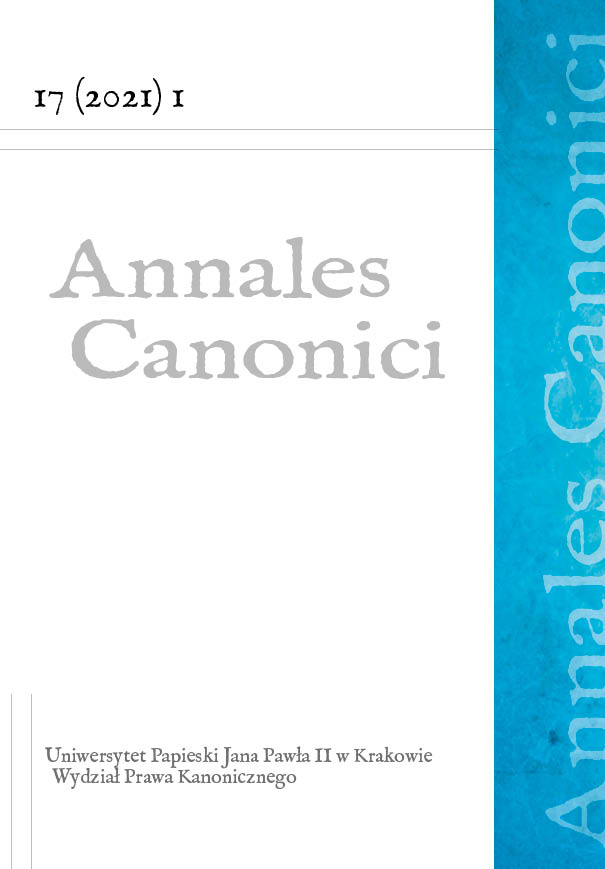The standing (locus standi) of the convent of Augustinian Fathers in Krakow in regulatory proceeding
DOI:
https://doi.org/10.15633/acan.3925Keywords:
legal entity, nacionalisation, standing (locus standi), regulatory proceedings, conventAbstract
While filing a petition and lawsuit pursuant to Article 61 Section 1 and Article 64 Section 2 of a relation between the state and the Catholic Church in the Republic of Poland, the legal church entity must produce its standing to file a petition (lawsuit), to support it and to acquire property rights. It must prove that it is the legal church entity that had been deprived of real estate ownership as a result of its nationalization (identity of entities), or a legal successor of this entity. Filing a claim to regain a nationalized property does not depend on whether this property was owned by the legal entity. There may be a legal succession in the strict sense of the word, or a right to regain the ownership of a property formerly owned by a legal entity of this Church (sensu largo succession), as stipulated by a relation between the state and the Catholic Church in the Republic of Poland. Identity or legal succession of legal church entities require an indication of legal basis in both canon law and Polish law. To meet this requirement, one must provide an interpretation of substantive and procedural law. However, it goes without saying that after unilateral termination of concordat from 1925 until 23 May 1989, there were no such legal norms in Polish law, because the legislator at that time avoided passing such legal norms, in spite of the existence of the binding regulation of the Constitution of the Polish People’s Republic in this respect. These issues have been analysed in detail in the article, using an example of nationalization and revindication of the real estate of a convent of Augustinian Fathers in Krakow.
References
Bar J. R., Kałowski J., Prawo o instytutach życia konsekrowanego, Warszawa 1985.
Baron J., Bączkowicz F., Stawinoga W., Prawo kanoniczne. Podręcznik dla duchowieństwa, t. 1, Opole 19573; t. 2, Opole 19583.
Grabowski I., Prawo kanoniczne, Warszawa 1948.
Insadowski E., Osoba prawna. Studium prawno-kanoniczne, Lublin 1927.
Michiels G., Principia generalia de personis in Ecclesia, Parisiis–Tornaci–Romae 1955.
Ottaviani A., Damizia J., Institutiones iuris publici ecclesiastici. Ius publicum internum (Ecclesiae constitutio socialis et potestas), Vatican 1958.
Sobański R., Komentarz do kan. 115 i 120, w: Komentarz do Kodeksu Prawa Kanonicznego, t. 1: Księga I: Normy ogólne, red. J. Krukowski, Poznań 2003, s. 191–192, 197–199.
Sobański R., Osoba prawna „in utroque foro”, w: Rozprawy prawnicze. Księga pamiątkowa Profesora Maksymiliana Pazdana, red. W. Popiołek, L. Ogiegło, M. Szpunar, Kraków 2005, s. 1355–1365.
Stec P., Walencik D., Rewindykacja nieruchomości osób prawnych Kościoła katolickiego w postępowaniu przed sądami powszechnymi, „Przegląd Prawa Wyznaniowego” 3 (2011), s. 23–50.
Walencik D., Rewindykacja nieruchomości Kościoła katolickiego w postępowaniu przed Komisją Majątkową, Lublin 2008.
Walencik D., Zabór mienia kościelnych osób prawnych w latach 1944–1989, w: Zakony żeńskie w PRL. Prawo instrumentem walki z Kościołem i zakonami w PRL, red. A. Mirek, Lublin 2009, s. 31–65.
Walencik D., Nowelizacja ustawy o stosunku państwa do Kościoła katolickiego w kontekście zasady bilateralności, „Forum Prawnicze” 2011 z. 2, s. 36–48.
Walencik D., Opinia prawna w sprawie osobowości prawnej Katolickiego Urzędu Parafialnego w Żyglinie i następstwa prawnego po nim, „Przegląd Prawa Wyznaniowego” 8 (2016), s. 221–257.
Zubert B. W., Komentarz do Kodeksu Prawa Kanonicznego, t. 2/III: Księga II: Lud Boży. Część III: Instytuty życia konsekrowanego i stowarzyszenia życia apostolskiego, Lublin 1990.
Downloads
Published
Issue
Section
License
The author declares that he owns the copyright to the work (article) and that it is not limited in the scope covered by the above declaration and that the work (article) is an original work and does not infringe the copyright of other persons.
The author allows the Pontifical University of John Paul II in Krakow to use the paper free of charge, non-exclusive and unlimited in time by, i.e.:
– keeping in records and reproduction of the copies of the work using printing, reprography, magnetic recording and digital technology;
– trade in the original or copies on which the work has been recorded (introduction to the market, lending or rental of the original or copies, public exhibition, display, as well as making the work available to the public in such a way that everyone can have access to it in a place and at a time chosen by them);
– inclusion of the work in a collective work;
– granting by the Pontifical University of John Paul II in Krakow a Creative Commons Sub-licence Authorship Recognition-Non-commercial Use-No Subsidiaries 3.0 Poland
The Pontifical University of John Paul II in Krakow makes the work available on the Magazine Platform of the university under the Creative Commons Attribution-Non-commercial Use-No Subsidiary Works 3.0 Poland license.
Thus, it entitles all interested parties to use the work under the following conditions:
- the author and the title of the work will be given,
- the place of publication (journal title and internet address of the originally published work) will be indicated,
- the work will be distributed in a non-commercial manner,
- no dependent works will be created.

